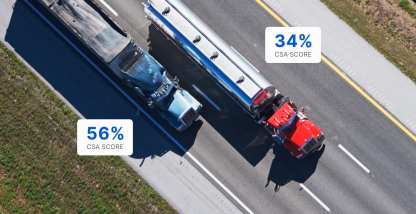CSA or Compliance, Safety, and Accountability is a program that the government came up with to ensure reliability and safety. The CSA score is used to decide whether you need a visit from the DOT or not.
As most fleets know, lower CSA scores are better. Drivers and fleet managers often try their best to keep their CSA score to the minimum. Lower scores pave the way to more clients and better business opportunities. Lower scores are also critical in reducing liability and ensuring clients and law enforcement that your fleet is committed to safety.
Read on for 6 simple secrets to learn how to improve your CSA score.
1. Take advantage of ELDs
ELDs can help improve CSA scores in many ways. First, drivers and dispatchers can keep a close eye on hours of service and get alerted when a driver’s limit is approaching. The top violations that roadside inspectors check for are operating an out-of-service vehicle and driving after being declared out-of-service. With an app like Motive (Android, iPhone), everyone involved can see the precise moment a driver is more likely to receive a violation if they keep going.
Egregious form and manner violations can also impact CSA scores. “Form & Manner” and “Outdated Logs” violations make up approximately 25% of roadside violations. These violations are common during roadside inspections. But they can be avoided if drivers log electronically. Because carriers don’t have to rely on drivers’ manually logging their hours correctly. And drivers won’t feel any pressure from managers to do so dishonestly.
A Form/Manner violation carries only 1 point. But an outdated log violation carries 5 points. So with an ELD that alerts you ahead of time, you can avoid these violations and the pesky hit to your CSA score.
2. Focus on pre-trip inspection
Vehicle maintenance violations make a big dent in CSA scores. And new criteria for keeping a truck in service can be difficult to keep up with. Thorough pre-trip inspections focused on vehicle maintenance issues that drivers tend to overlook are the most critical factor in preventing these violations. Industry experts recommend looking closely for air leaks in brakes, broken lights, and debris in tires.
Lights
Statistics reveal that broken lights are one of the most common roadside violations. In 2014, broken lights made up approximately 28% of all roadside violations. Also, they carry a whopping penalty of 6 points.
Tires
Approximately 11% of violations are for tires. And tire-related violations carry a severe penalty of 8 CSA points. So, make sure that you properly inspect tires and keep them in an excellent shape to improve your CSA score.
3. Watch your brakes
CSA scores can take a hit during Operation Safe Driver Week or Brake Safety Week. During these weeks, law enforcement ramps up roadside inspections and citations. Even though it’s super important, brake safety is an often overlooked aspect of pre-trip inspections.
According to Catherine MacMillan, an editor of SmartTrucking, dealing with brake adjustment and air leaks “is a more difficult and dirty job, that many drivers tend to avoid.” To ensure these critical tasks are taken care of, fleet managers can survey their drivers about what aspects of pre-trip inspections are more difficult to complete. Then they can provide instruction and/or resources to simplify.
The key here is to understand that brake-related violations are very common and can seriously damage your CSA score. In 2014, approximately 1 million brake-related violations were recorded. And each of those carried 4 CSA points.
4. Challenging citations
Carriers have two years to challenge a violation that lowered a CSA score.
Violations that are dismissed or result in a not-guilty ruling will be removed from a carrier or driver’s CSA score and Pre-enrollment Screening Program report. But claiming a charge should be dismissed isn’t the only option. Carriers can also challenge the severity of citation relative to the severity of the infraction. This could mean a smaller charge and a smaller dent to CSA scores.
5. Improve your hiring process
Companies who use PSP reports in their hiring process reduce their rate of out-of-service citations by 17%. They also reduce crash rates by 8%.
The ability to communicate effectively with law enforcement is also becoming very important. The drivers you hire should possess the following abilities when it comes to communication:
- Ability to properly fill out paperwork
- Ability to communicate with DOT officers
- Ability to answer officer questions effectively
You may not think of it as important, but these types of violations have been on the rise for the past few years. Currently, they constitute approximately 9% of all violations and carry 4 CSA points.
It can be easily avoided with proper training and the right hiring criteria.
6. Medical violations and CSA score
Approximately 12.5% of all violations are medical related. This is mostly because drivers don’t carry a valid medical certificate. Such violations carry a relatively smaller penalty of 1 to 2 CSA points.
But driving while physically ill is a more serious violation. That can set you back with a whopping 10-point penalty.
Fleet managers should actively track the expiration of their drivers’ medical cards and make sure that the medical cards are updated.
Bonus tip: how to improve your CSA score and increase driver safety with modern tech
Modern tech like fleet management software and dash cams can play a big role in improving fleet safety and CSA scores.
Video footage can help exonerate drivers when they aren’t at fault, promote a culture of safety, and protect your business from the uncertainties of the road. All of this may lead to a better CSA score.
Final words
The best way to improve your CSA Score is to avoid as many of these violations as possible. Driver training can go a long way in avoiding violations and improving scores.
Request a free demo to learn how the Motive fleet management solution can help manage your commercial fleet more effectively and improve CSA scores.






